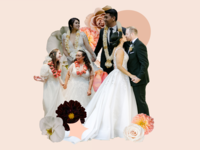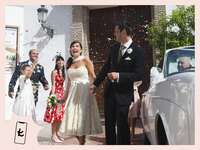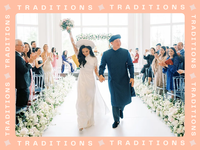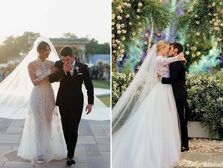The Complete Guide to Russian Wedding Traditions
Russia is the largest country in the world, with 145 million people and over 200 different ethnic groups representing a mix of European, Western and Asian cultures. In this vast and culturally diverse country, there's a wealth of distinct traditions influenced by Russia's rich history.
But there are some things Russian weddings have in common. Compared to other countries with serious and solemn wedding traditions, Russian weddings are fun, lighthearted and even whimsical, with a variety of games and pranks involved.
They are also an opportunity for elaborate opulence and warm hospitality. "Russian weddings have a heavy emphasis on details, entertainment and food. Overall, it's very important that your guests have an amazing time at your wedding," says Yekaterina Tsvetkova.
We talked with Tsvetkova, founder and owner of Treasures and Stories, an elopement and microwedding planner based in New York, who offered her perspective on Russian weddings in Russia and the States.
A Brief History of Russian Wedding Traditions
Russian wedding traditions are an interesting blend of long-held religious rituals, Soviet customs from the 1900s, and modern choices. Many of the Russian Orthodox Christian wedding traditions were established when Russia adopted the religion at the start of the last millennium. This changed in the early 1900s, when the Soviet state introduced "The Red Wedding," a secular event without religious meaning. Only the bride and groom were present for these weddings, which were more of a governmental contract and involved minimal decor, fanfare and no guests.
Current Russian weddings are more aligned with Western standards, but will often include some traditional aspects as well. For example, brides in Russia traditionally wore red up until the 1960s. Now, almost all choose to wear white.
According to Tsvetkova, "there is no standard way to get married in Russia today." In today's digital world, couples are inspired by weddings from all over the world that they see online, and often choose to incorporate features of those. In larger, metropolitan cities like Moscow, weddings take on a more modern twist with lots of trendy aspects and Western influence.
"Russian weddings have been incorporating more European and other Western details lately, like floral altar arches, first dances and bouquet tosses," says Tsvetkova.
However, some traditional customs are still incorporated, either for fun or to please family members. While this article lists many of the traditional Russian wedding customs, most modern Russian weddings will not include all of them, opting instead for a mix.
Russian Pre-Wedding Traditions
Several Days of Celebration
Traditionally, Russian weddings were several day-long events. Today, Tsvetkova says, this has taken on a more modern twist, with many couples planning two celebrations. First, they'll get married in a civil ceremony at their local city hall, then a few days later, a big celebration takes place at a beautiful venue outside the city. Some couples also choose to have a church ceremony as well.
The Ransom
A fun (but somewhat outdated) tradition is the bride's family members and bridesmaids "kidnapping" her and holding her for "ransom." The groom must complete a series of tasks meant to show his love (and embarrass him slightly). At the end, he must pay the ransom—a box of chocolates, a bottle of champagne, or another treat, to get his bride.
Russian Wedding Attire
The Bride and Groom's Attire
Traditionally, brides in Russia did not wear white and instead wore red, a joyous and festive color reserved for weddings. Bridal attire consisted of a sarafan, a sleeveless vest with shoulder straps, worn with a blouse underneath, as well as an ornamented headpiece decorated with rounded beads and gold thread. Nowadays, most Russian brides opt for a white wedding dress and bridal veil. According to Tsvetkova, "the bride's look is extremely important and a lot of finances are allocated for it." Similarly, most grooms will wear a tux or suit on their wedding day.
Guest Attire
Guest attire for Russian weddings tends to skew towards the more formal. Pretty dresses, hairstyles and accessories, polished makeup looks, manicured nails and clean dress shoes are all seen as very important.
For Russian weddings that take place in a church, modest attire is highly encouraged. Women typically cover their heads with a scarf, and longer dresses or skirts that cover the knees are preferred (but not demanded).
Russian Wedding Ceremonies
According to Tsvetkova, Russian weddings in Russia tend to take place in one of three settings: either at city hall, at a venue, or in a church. Russian-American weddings similarly either take place in a venue or a church. Each type of wedding is explained below.
Civil Ceremonies
Many Russians choose to be married in a civil ceremony at their local city hall, either alone or joined by a small group of guests. This ceremony follows a template that cannot be personalized, which includes the famous Wedding March by Felix Mandelssohn. After the ceremony, the couple is typically joined for a celebratory dinner with friends and family at a separate venue or restaurant.
Venue Ceremonies
The second way ceremonies take place are at beautiful venues, often surrounded by natural scenery. These venues have their own dining spaces and scenic outdoor locations for ceremonies. According to Tsvetkova, ceremonies begin with guests taking a seat, then live classical music played during the processional. The ceremony can last anywhere between 20 minutes and an hour. After the ceremony, guests enjoy cocktail hour while the couple takes photos throughout the premises of the venue.
Church Ceremonies (Venchanie)
Up until 1917, the Russian Orthodox Christian ceremony was the only way to get married in Russia, before it fell from popularity with the rise of the Soviet Union in the early 1900s. In the last 30 years, church weddings have experienced a revival, with many younger Russians choosing to incorporate them along with their city hall ceremony. "The church and the atmosphere inside create a very magical and unique atmosphere," says Tsvetkova. The church ceremony is divided into two parts:



The Betrothal Service
The first part of the Orthodox ceremony is the betrothal, where the couple becomes officially engaged to one another and their wedding rings are blessed by the priest. In this part of the ceremony, they receive lit candles that they will hold for the remainder of the ceremony, symbolizing the light of God in their lives and their willingness to accept him. This part of the ceremony also includes several prayers and scripture readings.
The Crowning Service
The second half of the wedding ceremony is the crowning, where the couple officially becomes married. During this part of the service, the couple stands on a piece of rose-colored cloth, which symbolizes their entry into a new life. The priest places a crown on their heads, which symbolizes that they will be the king and queen of their own kingdom. Traditionally, these crowns used to be worn for eight days following the wedding, but now couples remove them after the union is announced. The couple takes sips of wine from a shared common cup, and then follows the priest around the lectern three times, which symbolizes their journey into married life.
Witnesses (Svideteli)
It was once a legal requirement in Russia for a couple to have two witnesses, or svideteli, with them when they got married. Although this is no longer necessary, some couples choose to appoint two people as witnesses, who often serve as the best man or maid of honor. They often wear a special sash to differentiate themselves from the rest of the guests.
Smashing Crystal Glasses
A common tradition seen in civil, venue and religious ceremonies alike is the couple smashing crystal glasses that are given to them by their parents. The thought is that the more pieces or shards they create, the greater the number of happy years they will spend together.
Russian Reception Traditions
With so many geographic and cultural differences, reception expectations can vary by location. In St. Petersburg, for example, guests may join the couple on a dinner boat cruise, where they navigate through the city's beautiful canals and rivers. Regardless of where these events take place, the most unique aspect of Russian receptions is how playful they are. Couples place great emphasis on providing entertainment for their guests in the form of performers and games, with plentiful food and drinks. Expect lots of drinking and dancing, and to take part in the various games that will take place throughout the evening, like "find the bride," where the blindfolded groom is expected to find the bride among a group of her friends.
The Tour of the City
A Soviet tradition that has since become a bit outdated, but is still seen at some more rural weddings, is the tour of the city. Immediately following the ceremony, the couple, their witnesses and sometimes other friends, would join them in driving around the city, and taking photos in various places of historical significance. A more modern alternative is the Western tradition of the couple, families and wedding party taking photos as their guests enjoy a cocktail hour or other entertainment.
The Toasts & "Gorko!"
Russians take their toasts very seriously, so expect to hear quite a few during the evening. Tsvetkova says they can get pretty lengthy. In addition to toasts, guests will also randomly yell out "gorko!" which directly translates to "bitter," implying the drinks they are drinking are bitter. "The idea is that the kiss will dissipate the bitterness," says Tsvetkova. The longer the kiss, the stronger the marriage. This game isn't only fun for the couple, but also the guests who must finish their drinks when the kiss has ended.
The Tamada
Most Russian wedding receptions will include a tamada, a person who runs the entire reception with directions, jokes and games—like an emcee. "This person runs the whole night, and lets guests enjoy their time," says Tsvetkova. Tamadas are popular both at Russian weddings in Russia and in the States.
Russian Traditional Wedding Food, Drinks and Desserts
According to Tsvetkova, "food is important and so is variety." She says most Russian wedding feasts will include meat, vegetable and cheese platters, canapés with caviar and other delicatesse toppings, salads (including traditional Russian salads and hot dishes for the main course, which could include meat or fish.
Wedding Bread (Korovai)
A long-held Russian wedding custom is the korovai, a round wedding bread rich with meaning. A symbol of prosperity, well-being and fertility, this puffy, ornate bread was traditionally decorated with distinct designs—pigeons, flowers, the sun and stars—which symbolize different well wishes for the couple. Korovai has since been replaced by wedding cake, but many couples choose to still incorporate it in addition to the cake.
Russian Post-Wedding Traditions
Cleaning the Floor
As guests arrive at the reception, and throughout the night, they are encouraged to drop money on the floor. At the end of the reception, it's considered the bride's responsibility to clean up the money. It may seem like a hassle at the end of one of the longest days of your life, but the money is meant to help the couple establish their new life together.
Taking a Bite of Salty Bread
One last tradition as the newlyweds leave their reception is to each take a bite out of a heavily salted piece of bread. It is said that whoever takes a bigger bite will end up being the head of the household.
Frequently Asked Questions About Russian Wedding Traditions
How long does a Russian wedding celebration last?
Russian wedding celebrations can last for several days or even a week, with several events occurring in various locations.
What are traditional Russian wedding gifts?
Russians give generously at weddings. Guests are expected to give generously, paying not only for their plate, but also giving extra for the couple to establish their lives together. Plus, you should definitely bring some extra cash if the tamada calls on you!
Where can I see some examples of Russian weddings?
With so much diversity between Russian wedding customs, it can be helpful for a guest or someone planning a Russian wedding to see what others have done. Check out Russian wedding site, WeddyWood for more information.





















